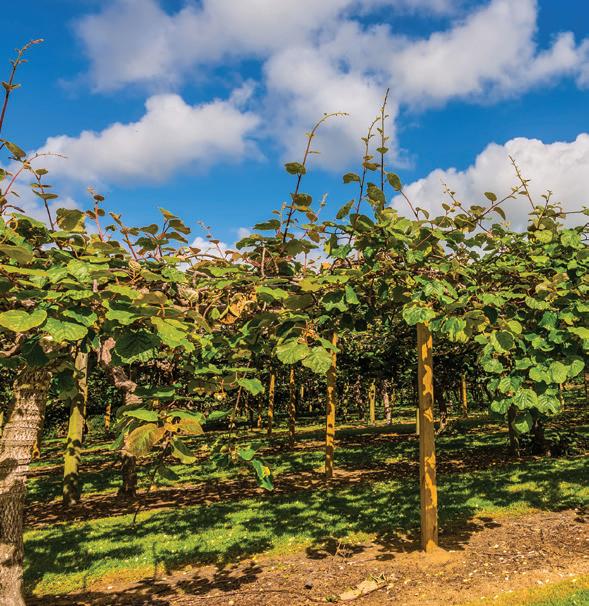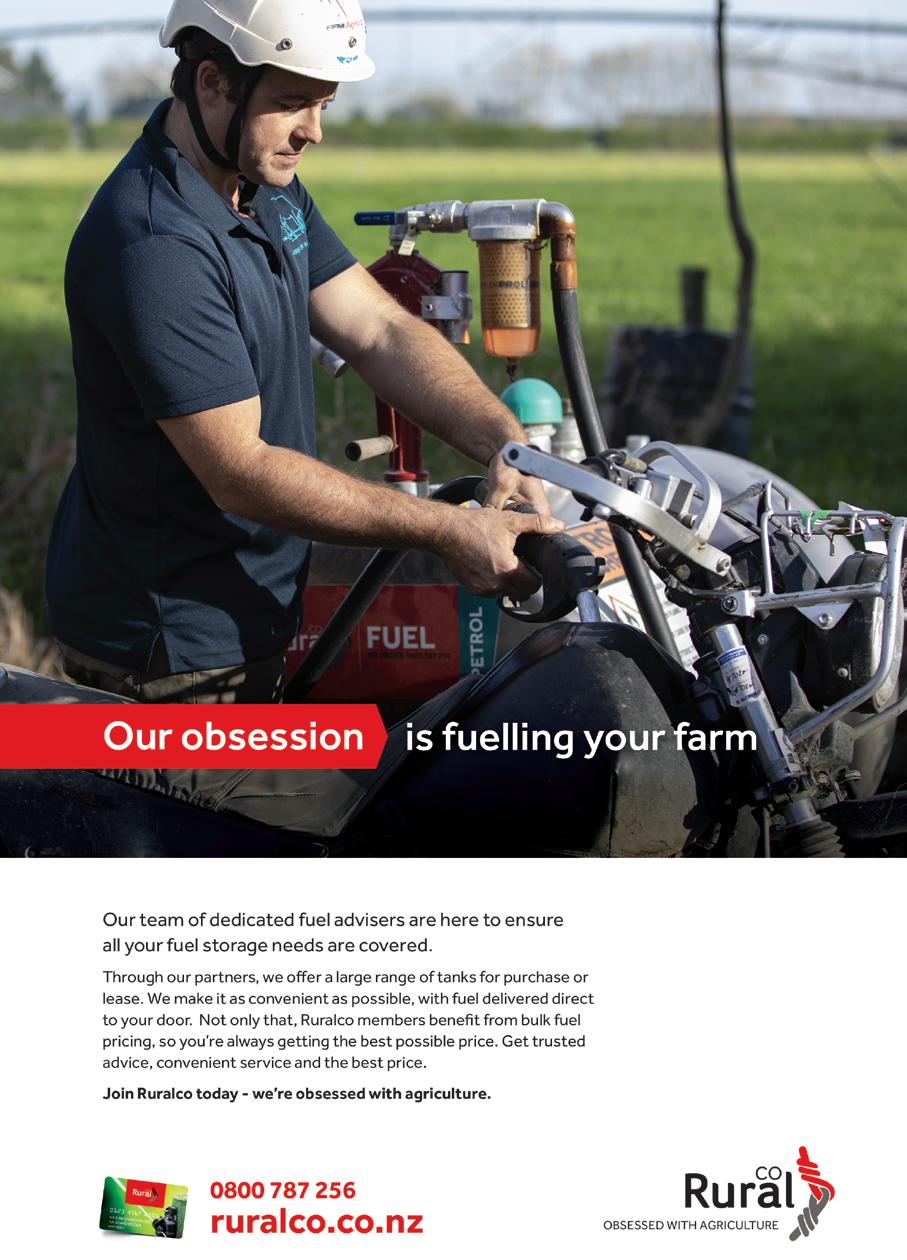
13 minute read
Primary sector powers NZ through tough times
by Ruralco
Recent data from Rabobank provided a very upbeat overview of how well the primary sector has weathered the turmoil of the Covid-19 pandemic. WORDS BY RICHARD RENNIE
Amidst that turbulence, New Zealand growers and farmers are poised to enjoy the fifth consecutive year of profitability in 2021. Whether it is milk solids, Manuka honey, wine, kiwifruit, or red meat prospects appear sound as the world’s consumers align their diets with good quality, healthy food from a country increasingly seen as an oasis against the turmoil of their own countries’ problems. Despite a year Rabobank describes as “bristling with risk”, analysts have expressed optimism about how production, costs and market prices will all pan out in coming months. This success has been attributed to New Zealand’s ability to keep Covid largely out, and for agri-supply chains to pivot during the peak of infection, enabling them to stay open and continue to function at close to full capacity. Good trade, diplomatic and personal relationships have also played a big part in keeping vital markets open, says Rabobank analyst Emma Higgins. But the year is most definitely not without its bumps, with concerns over Brexit trade negotiations, political upheaval in the United States, Covid mutations all playing into continuing global nervousness unseen in modern times. China’s claim to being the only country to experience positive economic growth in 2020 is being welcomed here in New Zealand by exporters, acutely conscious it now accounts for almost a third of our food export market. That country’s ability to largely control Covid, and New Zealand’s ability to artfully dodge contentious issues like Hong Kong governance, mean food exporters here have avoided the bans faced by many Australian primary producers. Food market guru and KPMG partner Ian Proudfoot says there is little for our primary sector from the past that can be applied to predictions for coming months, such is the volatility of the world’s plight. He appreciates the upbeat message some have for the primary sector’s year ahead, but tempers this with informed caution about how great the risks are for the sector to continue to grow and thrive in such challenging global conditions. “The message we are getting back from suppliers and marketers is that maintaining existing customers overseas is proving possible, through the likes of Zoom and Teams. But getting new ones is a significant challenge for many.” That absence of face to face contact, and inability to bring potential customers and clients down to New Zealand for first hand experiential contact with the product and the people who make it is significant, he says. That also extends to New Zealand’s loss of overseas tourism. The four million people a year who were visiting this country were invaluable converts to New Zealand products when visiting, seeking out those same products on their plate or pantry when they return home. Proudfoot cites the wine industry as a classic example of a sector that draws strongly upon the tourist trade where people visit a winery, sample product and maybe even meet the winemaker themselves in the process. His own first-hand experience travelling through New Zealand this summer reinforced to him that the tourism food experience was something the wine sector is doing better than most. “Places like Craggy Range have this amazing facility developed for customers to have a great experience. But if you cannot bring new customers in to have that immersive experience, how then do you make them a new customer?” Even processors like Zespri and Silver Fern Farms have made tours by overseas media and customers a regular part of their branding and marketing campaigns. He welcomes work by the likes of New Zealand Trade and Enterprise providing promotional material companies can access “off the shelf” to use to market their business overseas. The “Made with Care” campaign has been designed to help businesses make an impression virtually when Covid has made first-hand contact impossible.
Advertisement
Collaboration between sectors aims to enable the campaign to dovetail into existing promotions, including Beef + Lamb NZ’s Taste Pure Nature campaign running in China and the United States. Ian Proudfoot says some companies have proven adept at adapting to the new on-line demands overseas customers have driven as Covid shut down traditional retail outlets. He cites Zespri as one company that has done well, with digital sales soaring through the crisis as customers order on-line, while seeking out a trustworthy, healthy and well branded fruit product. Apple growers are also reporting continuing strong sales through the pandemic, with a plethora of licenced varieties entering the market in recent years meeting the spectrum of consumer taste demands. Large red premium Envy apples produced and licensed by T&G have had a record season with a 23% increase in international sales, generating one billion dollars’ worth. The company expects to be producing 15 million boxes a year within three to four years as orchards mature. Last season it produced five million. T&G CEO Gareth Edgecombe said Envy attracts prices between 25 and 50% over other apples and is gaining significant consumer acceptance for its sweet crunchy eating experience. Overall, prospects for horticulture remain strong, with MPI estimating a 9.1% growth in the year to June 2021, to $7.1 billion earnings. Consumer demand for fresh fruit has remained strong, despite the pandemic disruptions, and was expected to continue. Similarly, Manuka honey has enjoyed a surge in demand as customers seek out products that boost immunity and general wellbeing. Comvita, New Zealand’s largest honey producer reported late last year it had a 17% lift in revenue on the all-important Singles Day shopping event. It also recorded the third highest sales for any New Zealand brand across all categories on the online shopping giant Alibaba. Comvita CEO David Banfield attributed some of the success to a renewed focus on the company’s core Manuka honey product, and having its own team on the ground in China. Ian Proudfoot says the degree of “pivot” required by New Zealand food producers to adjust to a new world order in consumer purchase behaviour is significant. “In many cases that degree may only be 5-10%. But this is not a weatherable storm you can ride out with that. We need to plan for a 30-40% pivot. Am I seeing a lot being bold enough to take that at the moment? No.” He expects to see more digital platform sales come from the likes of the red meat, fruit and honey sectors this year as firms recognise the pandemic is unlikely to fade to insignificance soon. Despite the impact of Covid on the hospitality sector, the New Zealand wine industry has also managed to generally withstand the pandemic’s forced shift to in-home drinking throughout the Northern Hemisphere. In what was a memorable vintage not only in terms of quality but also circumstance, 2020 wine sales experienced very solid growth through the pandemic’s first nine months. Not only did volume sales lift by 11%, but value followed it by 10%. This contrasts markedly to Argentina’s 48% lift in volume, accompanied by massive discounting and an actual drop in value by 2%. The wine industry has managed to meet consumer preferences for lighter, crisper varieties with our distinctive Sauvignon Blanc, matching the same market’s food preferences for healthier, lighter foods so well suited to it. Tourism has helped buoy its reputation, and prior to Covid it was estimated over a quarter of tourists visiting New Zealand had a winery or orchard experience while here. Ian Proudfoot says his personal experience travelling through assorted parts of the country revealed a variable food experience, and now was the time to address that. “We sort of have a period of time to sort it out before opening borders to make sure we do have a great food tourism experience to offer throughout the country. At present some are definitely doing it better than others.” ANZ has estimated total tourist spend on food and beverages prior to Covid was about $6.7 billion a year, and was the fastest growing category of all tourism expenditure types. He maintains the opportunity to cement a closer link between farmers, tourism operators and hospitality outlets has never been greater, and is essential to attract the high-end tourists most likely to be the first to visit these shores post-pandemic. After fears of a falloff in dairy prices the new year has started strongly, with analysts predicting a lift in milk solid payments over $7.00 a kg milk-solids for this season’s production. A recent DairyNZ report highlighted dairy’s contribution of $20 billion to the economy in export value, and the key role it has played in supporting New Zealand’s pandemic afflicted economy. “Importantly, dairy sector growth is supporting wage growth in regional New Zealand.” “Dairy provides long-term stability for our communities. Export earnings translate to well-paying jobs, but also support farmers and dairy companies to purchase more than $22.5b worth of goods and services from other industries,” said DairyNZ CEO Dr Tim Mackle. Dairying accounted for five percent of GDP in most regions, including almost $2 billion in Canterbury and $2.5 billion in Waikato. “This is especially significant because of the limited scale of other high-value export sectors in rural New Zealand,” says Dr Mackle. The sector is now generating almost $3.5 billion in wages a year. Long-time claims dairying has not pushed for “value add” are also disputed by the numbers, with 2019 export value per cow being 50% higher than 10 years ago. DCANZ executive director Kimberly Crewther said since 2015 dairy export value has grown by over $5 billion, while cow numbers have remained relatively static over a volatile period in global dairy markets. “Covid-19 has highlighted the importance of reducing barriers to global trade in food. We hope 2021 will be when governments globally lean into reinvigorating the rulesbased trading system and turn statements on removing barriers to trade into real action.” BNZ senior economist Doug Steel says overall the New Zealand economy is in a far better place than he and his colleagues envisaged earlier last year. “And everyone acknowledges that agriculture has been remarkably resilient over this time. That is not only the ability to harvest, process and distribute, but also in getting goods to market and getting good prices for them.” The continuing success of primary sector exports and lower imports has had a remarkable impact on New Zealand’s trade balance over a tumultuous period. Globally he sees some more upside to New Zealand’s primary produce earnings should vaccines prove effective and economies respond to a receding pandemic threat. However he cautions that this may not feed through to even higher primary product prices. “The lift we will get in the Kiwi dollar will take some of the gloss off that towards the end of the year, the market will price that in.” Should the global economy pick up with greater confidence then a Kiwi dollar at US76c later in 2021 is quite possible. “We need to be cautious not to look at the dollar in isolation, as it is a good indicator in that as it rises our economy is doing well overall.” “It is no coincidence we saw the dollar go to over US80c when the dairy payout lifted over $8 a kilo milk solids in 2013-14.” Similarly, the Kiwi dollar will act as a buffer, should export prices drop due to any further loss in global confidence about a pandemic recovery. He also sees the recent upgrade of the New Zealand-China free trade agreement as a positive signal for our relationship with that country. “The signing of any free trade agreement is a positive signal in this age of trade tensions around the world.”



B+LNZ launches beef genetics programme
B+LNZ Genetics newly launched beef programme is designed to generate more income for
this country’s beef producers. WORDS SUPPLIED BY BEEF + LAMB NEW ZEALAND

In response to consumer demand for high quality food produced with a lower environmental footprint, Beef + Lamb New Zealand Genetics has launched a comprehensive future-focused beef programme. Designed to generate more income for this country’s beef producers, modelling has shown that through this programme, farmers can increase the beef industry’s income by $460 million, while improving environmental and social outcomes. Dan Brier, B+LNZ Genetics’ General Manager says with the right science and tools, farmers will be able to produce great tasting meat with a good environmental story, while maintaining and improving their production efficiencies. “Our meat companies are already moving in this direction, with several introducing quality grading systems and working under the Taste Pure Nature initiative to target the “conscious foodie” consumer.” He says the programme incorporates four areas of work which include the development of NZ-centric breeding objectives. These will be focused on this country’s pasture-based system where cows play a dualrole of supporting sheep production, while producing a high-quality product. A data measurement and collection system will be developed to collect phenotypic and genotypic data and a new Beef Progeny Test, using Angus, Hereford, and Simmental genetics, will identify the performance of the agreed-on traits linking with international beef and dairy beef genetics. Another area of work is the use of next generation commercial genomic tools to support stud and commercial operations. Commercial farmers, who are performance recording, will be used to ground-truth these tools and provide broader-based performance data and feedback. Dan says B+LNZ Genetics will use their experience of building a genetic engine for sheep to build a similar engine for beef, combining phenotypic, genotypic, and genomic data to calculate breeding values for agreed traits. Ultimately, under the Beef Programme, B+LNZ Genetics plans to extend nProve genetics systems to include stud cattle. This would give commercial users the ability to quickly and easily source the right genetics for their environment and farm system. “The final and arguably most important part of the Beef Programme is industry uptake and we will bring a laser-like focus to this challenge, ensuring we are transferring knowledge to commercial farmers and making cutting-edge tools and resources available to the beef industry.” AbacusBio consultant Jason Archer is the Science Lead for the Beef Programme and says the industry cannot get caught in the commodity trap. “We need to improve eating quality under our farming systems and capitalize on our strengths as a ‘natural’ producer.” He says having great eating quality is essential to underpin the branding of NZ naturally produced beef. “If the beef doesn’t eat well, there will be no repeat buyers.” The Beef Programme is about making sure the industry can produce consistently good beef, beginning with the breeding cow in the context of her role in NZ’s farming systems. But one of the main purposes of the Beef Programme is to create a data and information platform that can be accessed by everyone from bull breeders through to commercial farmers. “It’s about providing an ecosystem that will help breeders, either individually, in small groups or as a society, innovate and interact.” This innovation might be the identification of a specific trait of interest, and the system should allow breeders to pursue that trait. “It’s enhancing peoples’ ability to do new things and that’s really important,” says Jason. Jason says they would like to encourage more commercial producers to collect data for traits such as carcass quality and maternal performance. “I see an opportunity for bull breeders to work with some of their best clients, and encourage them to get into a level of commercial recording which would then provide information on the genetics of their herds. This information can be shared back with the bull breeders to help improve the next generation of cattle.” The NZ beef industry is made up of 25,000 farmers and 3.6 million beef cattle. Of these, one million are breeding cows which combine with the dairy herd to produce 1.4 million animals for processing annually. Beef exports total $4.2 billion.













